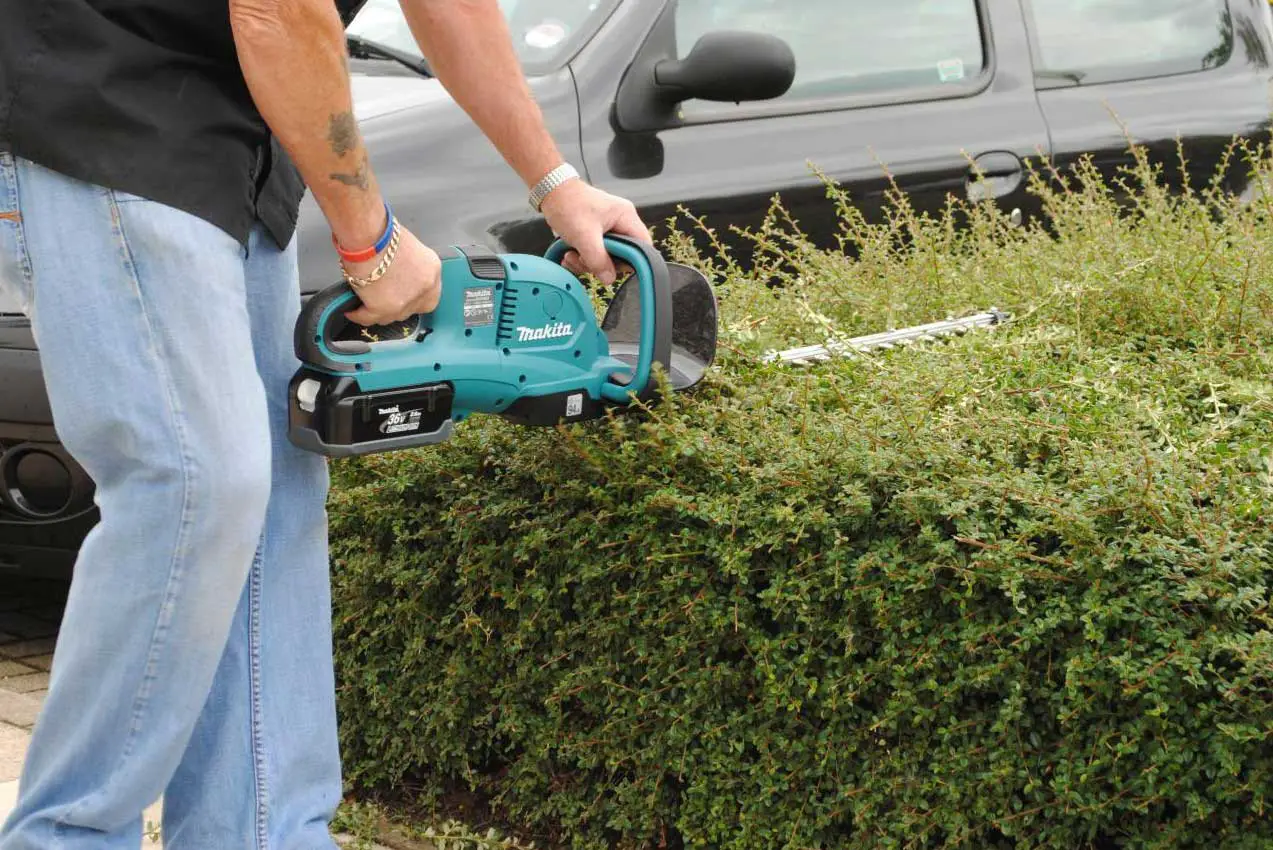It’s great to live in an age where we have so many useful power tools at our disposal, isn’t it?
Not so long ago, your only option was to use hand shears, and that doesn’t bear thinking about (although they still have their uses).
Back-breaking jobs that once took hours can now be completed relatively quickly and easily, with amazing results. And if you have hedges in your garden, you’ll know all about that!
We’re not even talking about something like Hampton Court Palace maze here: even a modest garden with hedges on three sides can be a real time-consuming chore, especially if you only cut it back once in a blue moon. These handy gadgets certainly make life easier!
Cutters Or Trimmers?
So, do you use a hedge trimmer or a hedge cutter? Is there a difference between hedge trimmers and hedge cutters, or are they one and the same thing? After all, many sellers use the two terms interchangeably. This is clearly a method to catch more online traffic, but it doesn’t help the consumer who wants to know the difference between the two.
When you search online for hedge cutters, you’ll get a bunch of results. But when you go into any particular website, they’ll invariably show you a list of hedge trimmers for sale. So, how do you know what’s what?
Let’s take a closer look and try to clear up the confusion!
Hedge Trimmers Vs Hedge Cutters
Basically, the clue is in their names; while they both essentially cut hedges, one is for light work (trimming) while the other handles heavy-duty work (cutting).
For the most part, you’ll only need a hedge trimmer. These are used to shape the hedges and keep them under control.
However, if your shrubs, bushes and hedges have gone wild and now resemble a jungle, or you’ve moved into a new property with a large, neglected garden in need of some serious work, you might want to invest in a hedge cutter.
To help you out, here are some examples of what’s available:
Electric Hedge Trimmers And Hedge Cutters
An electric hedge trimmer has a power cable that connects to your mains electricity. It’s fairly lightweight and manoeuvrable, doesn’t need charging and won’t run out of fuel.
The main contention with an electric trimmer is that the cord can be a pain, as you have to watch that you don’t slice through it with the machine or trip over it while working. You also, obviously, need to be constantly connected to a power source, and that means you’ll probably need an extension cord.
As for whether the machine is suitable for trimming hedges or can cope with thick branches, you’ll need to check each individual model. Yes, it’s a pain! But on the whole, electric hedge trimmers are geared towards light use. The last thing you need is to bend or break your hedge trimmer blades trying to cut through thick branches.
Out of the three different types of cutters/trimmers, electric ones require the least amount of maintenance.
Check The Specs!
The trick is to look at the description of the trimmer carefully. All good sellers will include a recommended cutting capacity which indicates the maximum thickness of the material it can handle. Don’t go purely by the size of the blade! It also depends on how powerful the machine is and the size of the gap between the teeth.
On the whole, lightweight electric trimmers can handle branches up to ¾ inch thick. If you suspect that you’ll need something that can cope with thicker branches, check the specifications carefully for longer blades with more space between them.
Battery-Powered Hedge Trimmers And Cutters
A cordless trimmer has the obvious advantage of being portable and unencumbered by a cable, giving you more control without having to worry about tripping over the cable or cutting through it.
The downside is that they need charging periodically, and they generally lack the power of a petrol-driven model. However, modern battery-powered trimmers are pretty powerful, often more so than many mains electric trimmers.
This means they will cope better with thicker shrubbery than most electric models.
Aside from the advantage of being more mobile, battery-powered cordless trimmers are easier on the ears as they don’t make a lot of noise and they don’t produce fumes. They need regular maintenance, but not as much as petrol-powered hedge trimmers.
Petrol-Powered Hedge Trimmers And Cutters
These are usually more powerful than electric cutters and trimmers because they need to house a petrol-driven engine. As a result, they are typically sturdier and more robust.
This makes them better for heavy-duty work, but don’t be tempted to cut through thicker branches regularly if they exceed 1¾ inches. You are likely to bend, break, or dull the blades if you do so.
These machines (known as gas-powered trimmers or gas-powered cutters in the US) can be used to trim hedges that are mature and well-established, especially those that are thicker and heavier.
So, these models are more likely to be regarded as cutters than trimmers, although it is still wise to check the specifications to ensure you have a tool that can cope with the job at hand.
These models require a lot of maintenance to keep them in good working order. Aside from applying regular lubrication, you’ll need to check the spark plug, carburettor (which gets gunked up when left too long without use) and air filter.
They tend to vibrate more than other units because of their increased power, which can cause screws and bolts to loosen, so these will need checking and tightening, too.
You also have the added hassle and associated hazards of acquiring and storing petrol.
Safety Note
Power tools are useful but must be used with caution. It is essential that you read the manual and take note of any cautions or warnings, and invest in appropriate protective equipment, like safety goggles, gloves, and ear-defenders (especially so when using a petrol-driven hedge trimmer) before trimming your garden.
Also, it’s no good buying a lightweight trimmer that’s not designed for cutting through tree branches and simply hacking away until you get through. Aside from breaking your hedge trimmer’s teeth, the blade may become lodged in the branch and burn out the motor/engine.
This is bad news as it will cost a lot to repair or replace, but there’s also the chance that this may lead to fire or electric shock. Any power tool should only ever be used for the purposes stated in the manual or advertisement. Doing otherwise can result in injury, or worse.
Whether it’s for trimming or cutting, all models have their limits. It’s best to take stock of what work your garden needs and invest in the proper tools for each job.
A Quick Summary
We’ve looked at the difference between a hedge trimmer and a hedge cutter, and here’s a quick recap to get things clear in your mind:
Hedge Trimmers
Hedge trimmers are generally for lighter work, thin branches and occasional use, mostly for shaping and keeping the hedges neat and tidy. These can be used on young, small bushes as well as mature hedges that need trimming. The blade length is usually shorter, as is the space between the teeth.
Most hedge trimmers, whether petrol, mains, or battery-powered, can easily cope with twigs or small bushes and thin branches up to ¾ inch in thickness. However, battery-powered models are typically more robust than corded hedge trimmers.
Hedge Cutters
Hedge cutters have wider blades that are more widely spaced, allowing you to tackle thicker branches.
Petrol-powered models are generally more rugged and powerful, many with longer blades and wider gaps between them.
These are great for cutting hedges that need more work, perhaps where they have been neglected for a while. They will also easily handle larger branches, but there is a limit!
For anything much thicker than 1¾ inches, like tree branches, for example, it’s better to invest in a pruning saw or a mini chainsaw.
Which Is The Ideal Tool For The Job?
In reality, there may be only slight differences between a hedge trimmer and a hedge cutter.
And when it comes to choosing the right tool, personal preference is bound to play a part.
However, it pays to take your time and consider all the aspects involved. If you have a large garden with mature trees and formal hedges, you might want to invest in a petrol-driven hedge trimmer or hedge cutter. Maybe you should even consider both? Either way, you’ll need to look at tools that can cut through bigger branches.
What Else Can It Do?
Also, give some thought to any other qualities that the hedge trimmer or hedge cutter has to offer. Some are specifically designed to tackle tall hedges, others are combi-tools that can trim the edges around flower beds.
Some models allow you to move the two blades into different positions, making life easier and helping you to achieve the desired shape to your hedges.
The Verdict?
Petrol-powered models are good for larger gardens if you don’t mind the extra weight, fumes, and maintenance. They are also better for heavier work than the average hedge trimmer, and many of these models will handle
Electric hedge trimmers are a more general tidying tool, used to shape hedges that aren’t too big or wild.
Overall, modern cordless trimmers offer the best advantage: they are sturdy, lightweight, powerful, and extremely mobile. If you use a hedge trimmer fairly regularly, this is a great choice for keeping the garden tidy.
And if you anticipate having to cut through dense bushes and slightly thicker branches, you could find a model with a better cutting capacity that could be described as a hedge cutter.
Of course, you could get out the hand shears next time your hedges need a trim. Joking aside, it’s good to have a pair of these handy as they are useful for quickly dealing with thicker pieces of hedge without risking damage to your machine.
Finally, happy gardening, and always work safely!


